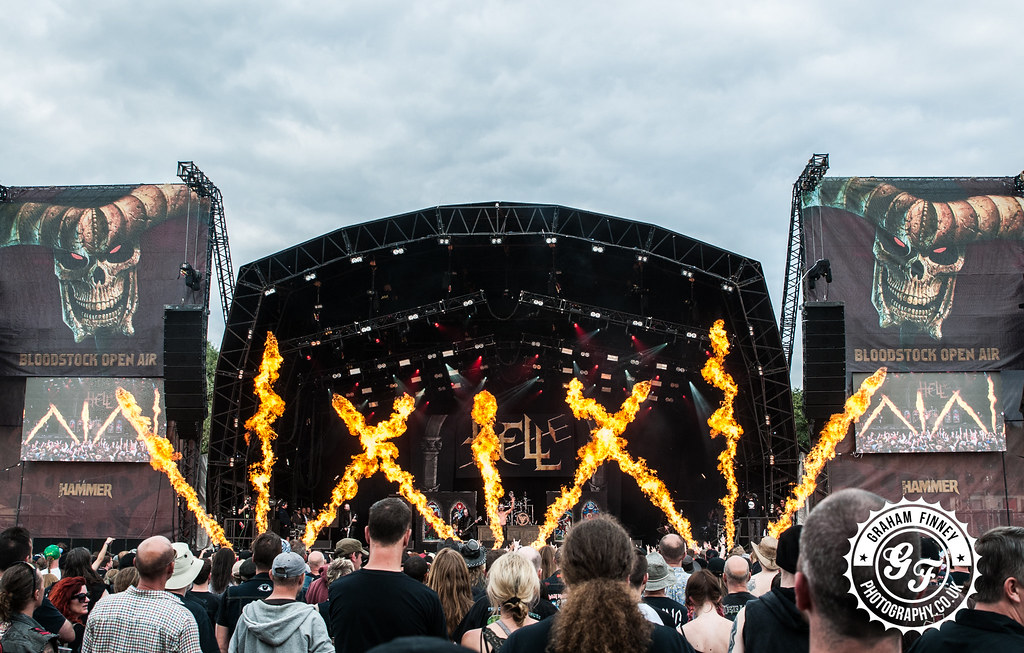Features
METALHEADS in Europe; A Quick Review of the Continent’s Most Metal Countries Prompted by One Simple Photo
Metal-Archives.com shared a photo which prompted us to look a little closer at the wacky-but-awesome community of Europeans Metalheads.
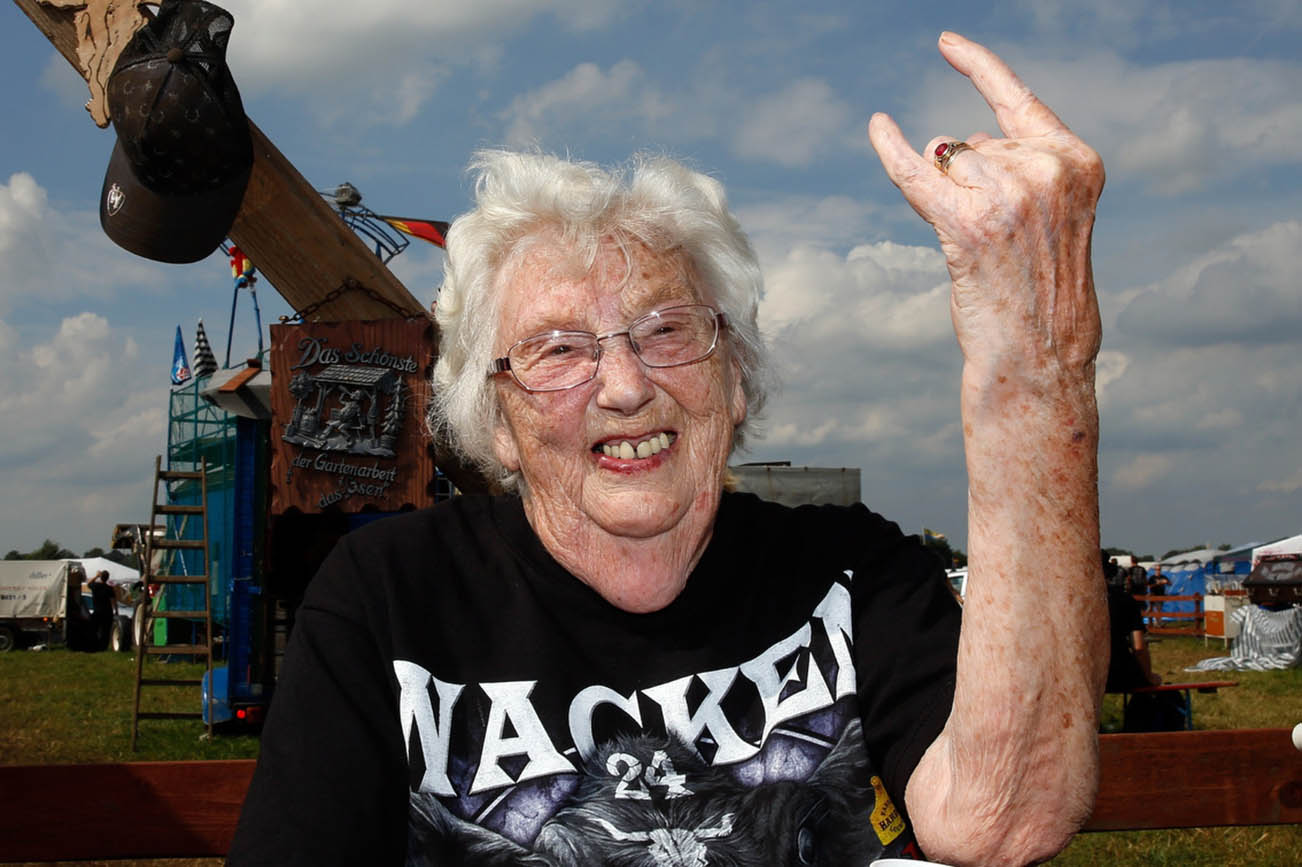
The directive came in from Head Master Gonda recently. “Hey Kevin,” he cajoled me over the interwebs, “can you do me a favour and extract your gleaming cranium from its usual ‘embedded in your rectum’ routine and put that unfinished journalism degree to some use? Give me a few hundred words on what you think of when you see this map? Oh, and can I get your copy by the end of July? Thanks, buddy!”
And here I am. On time, as usual, because I know that by asking me to submit something by the “end of July” means Our Fearless Leader’s deadline is actually mid-September, if not Christmastime. After spending far too much time staring and thinking and ruminating and mulling, I’m spilling my thoughts on paper (or screen or whatever) in a combination of Rorschach Test meets Rosenzweig Picture-Frustration Study meets Word Association exercise (by the way, that previous sentence just might be the first time in years I’ve actually put the two degrees I have in psychology to use since obtaining two degrees in psychology. Yeah, I have a lot of degrees, but not a lot to show for ‘em).
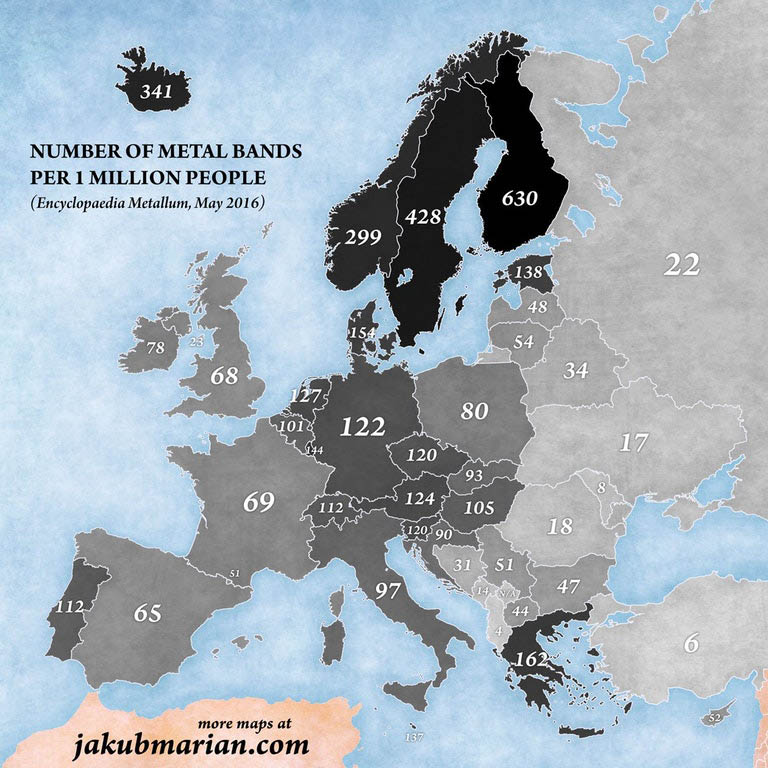
So, what sorts of information can one glean from eyeballing this European country-by-country breakdown, courtesy the folks at Metal-Archives.com? Well, it absolutely confirms what anyone who has been listening to metal for more than two weeks already knows: Scandinavia, specifically Finland, is the international hotbed for this type of music. And before you get all ‘pish-posh’ about how this is only a map of Europe and ignores the fact that there are six other continents on the seething cesspool that China and the American E.P.A. is rapidly grinding into toxic stardust, if you’ve been listening to metal for more than two weeks you should know that Europe is ground zero for metal in the first place. That Finland is home to the largest concentration of bands per capita is a tidbit already well-known, well-established and well-covered by the majority of the metal press, including Decibel Magazine which ran a full-on Finnish issue a couple years back.
This is the country in which members of bands are restaurant-owning celebrities; where metal albums regularly dominate the charts (at the time of my writing this, Wintersun’s The Forest Seasons is #1 on Finland’s album chart); where, when Nightwish ousted original frontwoman Tarja Turunen, the band had to employ a series of cloak-and-dagger moves to shuttle Turunen’s then-replacement (Anette Olzen) into the country under the nose of camped out press corps; hell, it’s a nation where Turunen still maintains a career; it’s a country where dedicated bangers I know personally have relocated to in order to be closer to the significant others they met online and the metal (but mostly the metal).
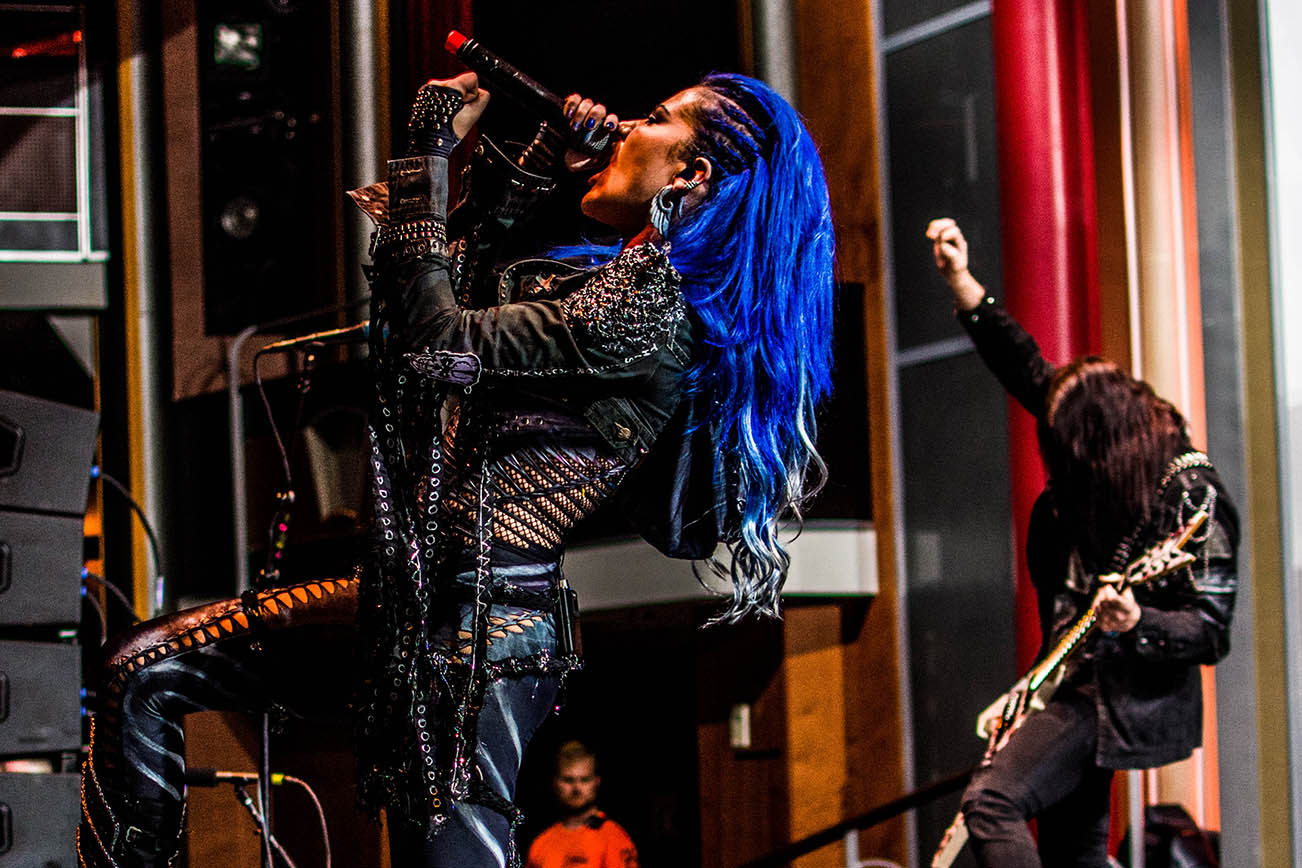
Of course, this generally and mostly speaks to the mainstream side of the metal world, but there is always something bubbling in the comparative underground in the fields of doom, grind, death, thrash and black metal. Funereal doom is actually a national movement that’s moving quicker than the four or five beats per minute of its creators and performers. Bands like Amorphis, Moonsorrow, Children of Bodom, Omnium Gatherum and Impaled Nazarene are still going strong decades into the game and there’s the whole folk metal movement which managed to incorporate accordions into metal and have it not sound (totally) cheesy. There are countless examples of Finnish dominance when it comes to all things metal, though nothing more than when you have a former leader of the free world, U.S. president Barack Obama, saying during a visit to Lapland last year: “I do want to point out that Finland has perhaps the most heavy metal bands in the world per capita and also ranks high on good governance. I don’t know if there’s any correlation there.”
Norway has historically had the market cornered on black metal, which seems to still be a thing as many long-in-the-tooth outfits like Mayhem, Satyricon, Enslaved and Darkthrone are continuing on their merry way while members from original wave bands splinter off into other projects and other subgenres, the most prominent example being Emperor’s Vegard “Ihshan” Tveitan prolific and progressive solo career. And despite the dicey history metal has had with the nation’s good citizens, metal is considered a legitimate art form as bands from the extreme side of things regularly find themselves nominated for a Spellemannprisen (the Norwegian equivalent of a Grammy) and black metal is an ingrained and entrenched part of the culture. An acquaintance of mine once recounted a story of his arrival in Oslo and getting into a brief and jovial conversation with a customs agent about his Norwegian holiday which was set to include what the receiving official pointed out was “black metal tourism.” Compare how quickly Norway has come to accept the legitimacy of metal following a spree of murders and arson in the ‘90s with how metal is still viewed and vilified by many of the sentinels of North American society as a gateway drug to a lifetime of nefarious calamity ultimately leading to a final resting spot in Hades.
Former U.S. president Barack Obama on metal in Finland
Sweden’s metal scene itself is responsible for entire subgenres of the music: think melodic death metal (often equated with the entire city of Gothenburg), death ‘n’ roll and HM-2 pedal driven Swedish death metal. Books have been written about the scene, compilations have been culled in tribute and you know you’re doing something right and have defined a sonic niche when you spawn legions of copycats from around the world. Former Entrails bassist/vocalist Jocke Svensson (now of grinders, Birdflesh) once said to me in an interview whilst on the promotional rounds for their 2015 album, Obliteration that, “German bands are doing Swedish death metal better than most Swedish bands these days.”
This then brings me to some of the other observations that sprung to mind in perusing this map, some of which are more surprising than others.
First, that the number of German bands is so middle-of-the-road when lined up against the rest of the old world. Who’da thunk there would be more metal bands per capita in Estonia, Austria and Greece with countries like Portugal, Holland, Switzerland and Belgium not far behind? On the one hand, this is understandable in that Germany has always been recognised for providing a loyal and solid fan base for metal – one that didn’t blink and give in to the so-called tastemakers the same way North America did to grunge and nü-metal throughout the ‘90s – and while there remain a large number of bands per capita, Germany’s strength lies in the devotion of the punter. I mean, this is the land in which Manowar is king, so they’ll obviously listen to and support anything, but as far as active bands per capita, it would seem our Teutonic friends are more straight up fans as opposed to the sorts of people spending long hours jamming in disused underground bunkers.
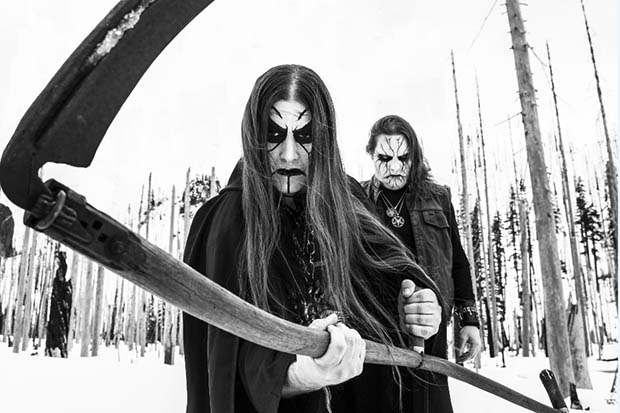
Next, who would have ever thought that Iceland would be kicking as much ass as they have as a metallic country? While technically considered part of Scandinavia and the result is that it ups the overall Scandinavian average of bands per capita, the population of the island nation itself lingers at about one-third of a million in the first place and appears to be shedding the barriers erected by the once geographic and cultural isolation. Iceland has a huge black and death metal scene and maybe kids are tapping into an expression of anger with socio-cultural strongholds that didn’t really exist until the country was in the midst of financial crisis a few years back. This might be the artistic result. At the same time, Metal Archives doesn’t even list/consider the country’s biggest metal export, Solstafir, so there may be something more on edge and curious brewing amid the hot springs, volcanic rock and lack of vegetation.
The omission mentioned above demonstrates that tabulating an accurate number of bands in the entirety of any nation is an inexact science at best. Metal Archives is itself known for rejecting entries of bands they don’t feel are “metal enough” or those that live up to whatever their subjective standards and criteria are. I mean, Solstafir isn’t given play on the site, presumably because they’re not strictly a metal band (their status could be argued either way), but they played Maryland Deathfest in 2014 and are signed to Season of Mist. At least a couple heavy hitters out there recognize some amount of metal in there, even if you don’t think much of them at all. As well, one of best bands I’ve discovered over the course of the last two years, Vorvan from Russia, isn’t mentioned in the website’s individual listings either. This oversight could be because the band from Moscow has ties to hardcore and avant-garde sounds. Or not. Additionally, I know from personal use, experience and research that many bands still in the nascent stages of their hopeful careers haven’t got around to putting themselves up on Metal Archives at all, which might not be the smartest move for the band and not something for which you can point a finger at Metal Archives. However, it also means some amount of music, even if it’s a small percentage, is being overlooked. Then again, it might be another hundred Scandinavian bands waiting to be added to the list further upping their stranglehold on this non-existent title.
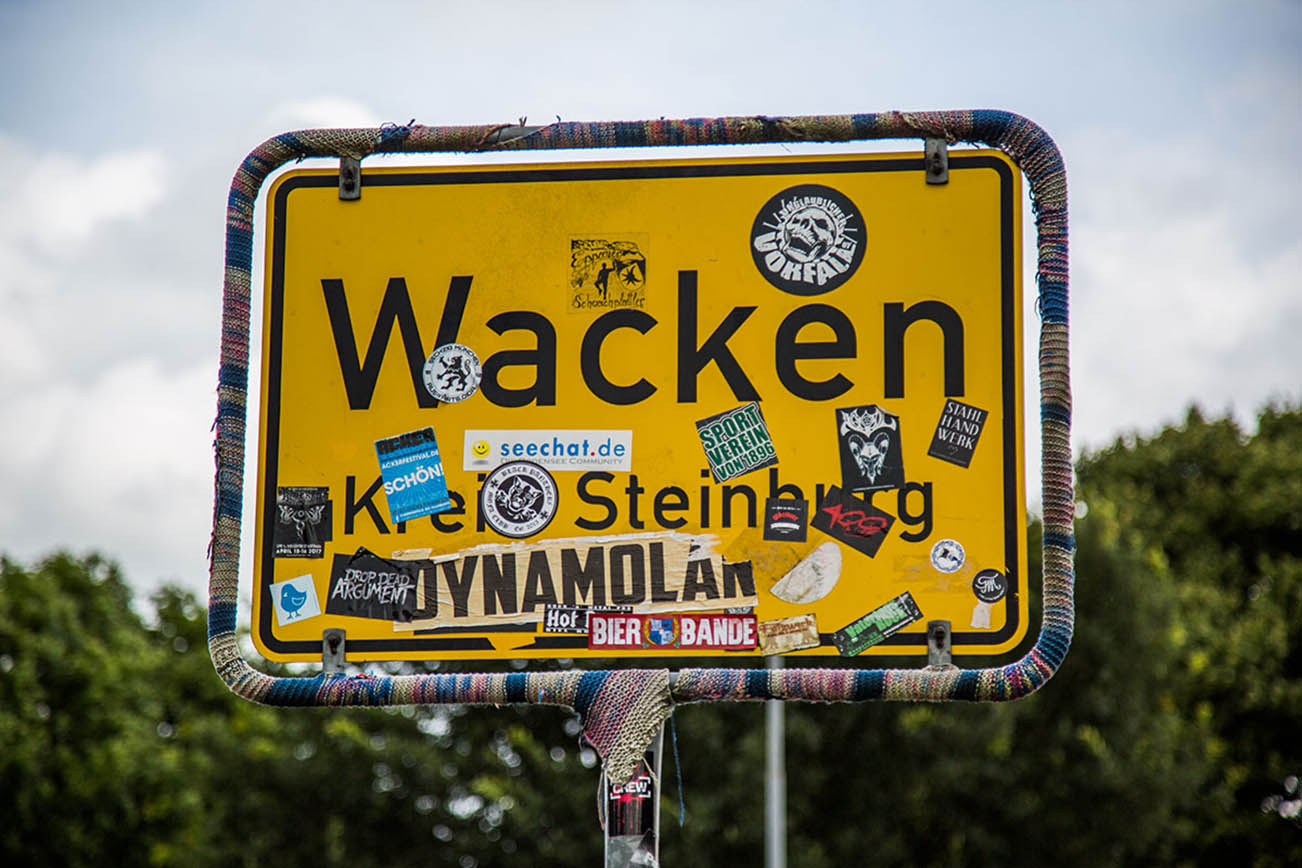
As mentioned repeatedly, the take home message of this map is that metal rules the western European roost. This is no surprise – never has been, never will be. Underlying this message for those of you in bands is that the first thing on the top of your to-do lists is to get overseas and tour Europe. Actually, that should be the second thing; the first should be to focus a good amount of your promotional attention and energy overseas if possible. Of course, the goal every band not based in Europe wants to knock off their bucket list is to play in Europe. This is in the same way that bands that don’t call North America home eventually wish to make it over to these shores; that which they consider the holy grail of tour opportunities.
The grass is always greener on the other side and all that. It may be commonly understood that the treatment of bands by promoters in the Old World is head and shoulders above the sometimes shoddy treatment of bands by promoters and venue staff on this side of the drink, know that when you have nations like those with higher numbers of bands per million, the resulting effect is that you often find the majority of people who attend shows are in bands themselves. This is cool, but it also often translates into shows populated with crowds of musicians who are bound to be overly suspicious and critical of your performance, if not outright jealous. There might not be a lot of the sort of “let loose and rock out like there’s no tomorrow” that brings the energy to a gig. Various Swedish and Norwegian musicians have expressed to me over the years that the vibe at club shows in their home towns is so staid and reserved because musicians dominate the crowds at gigs. Are you familiar with this old joke? Q: How many guitar players does it take to screw in a light bulb? A: 20. One to actually screw it in and 19 to stand watching with their arms folded saying, “I can do that.” Well, imagine flying a few thousand kilometers and spending a few thousand dollars for the privilege of eliciting that reaction.
Check out a trailer of the film Metalhead
Additionally, metal fans in countries like Germany and France have been known to hold live performance to exacting, often ridiculous standards. I’ve heard from multitudes of North American bands about how they will be told straight up to their faces by fans in these countries when a show is lacking, pointing out miniscule timing errors or flubbed notes. And not only that, but they do it with a Trump-like sensitivity and sometimes act like it’s both a personal affront and an insult from one nation to another.
Please understand that I’m not telling you to avoid touring Europe, or to avoid those countries when booking your triumphant descent upon the motherland; by all means, go for it. Fuck, if I was in a band, I would. When I was in a band, part of our reasoning behind signing to a European label was that they’d promote and bring us over. Just make sure you’re either super-prepared or take the time to grow some thick skin. It’s like Goatwhore frontman, Ben Falgoust said during a recent interview on the topic of his band’s plan to play Europe more during the touring cycle for their newest album, Vengeful Ascension, “Europe’s a different market than the U.S. They get a lot of great bands and tours and it’s a smaller area, so a lot of people are jaded because they see so much. When you go over there, you can’t go over half-assed, you have to go over at 150% because people are going to be, ‘I saw eight killer shows last week and you come here and you’re only so-so? Nah!’ They’re definitely really dedicated metal fans. When you see people at shows, they’re lifers, not weekend warriors. It’s a totally different scene.”
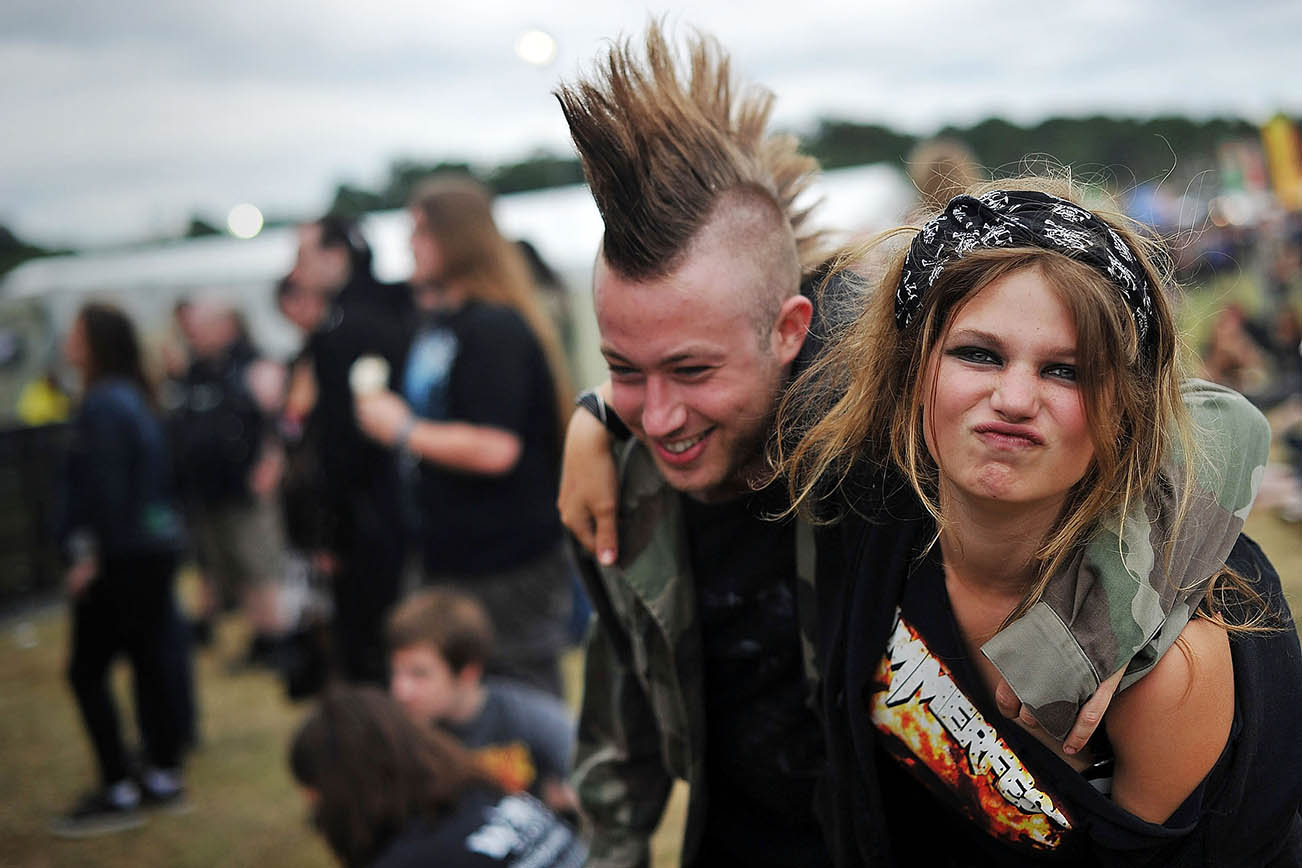
Metal is deeper ingrained in the culture over there and they’re more die-hard and dedicated which in a circular sort of way, is why I’m discussing the map as it is in to begin with. So, maybe the first thing you should do before promoting yourself throughout Europe or even thinking about going overseas, is to make sure you don’t suck. You’d be doing everyone, not just Europeans, a favour.
Other points of note: I’m surprised at the higher numbers of bands in Eastern European and former communist bloc countries like Slovenia, Croatia, Hungary, Czech Republic and Slovakia. Not that metal is a new thing to any of those nations – there are plenty of bands that existed in these countries even when they were communist strongholds – but my surprise is strictly personal as I haven’t heard of a great number of the bands hailing from these countries, save the Czech Republic which has a long history of forging musical steel.
I am surprised, however, at the relatively lower number of bands per capita in the UK, which was the birthplace of this whole metal mess in the first place and spawned the original New Wave of British Heavy Metal. Just tabulating the number of NWOBHM bands that have got back together in the past couple of years should have shot their total through the roof. I guess an increase in population (I think London, at last count, had 4 squintillion people living in its city limits) and a more cosmopolitan society that’s welcomed people from all over Europe who have brought and maintained their traditions whilst on UK soil would naturally result in the capita side of the equation rising while the metal band side remaining as is. But that’s pure armchair quarterbacking and conjecture from someone who’s never visited the place to begin with. So really, what do I know? Concrete conclusions weren’t the goal here anyway. Remember, my marching orders were to rattle off what comes to mind after taking a look at the original map. Whether or not you agree with any of my above ramblings is your choice, but I’m sure you’ll be with me in thinking, “Holy shit, look at Luxembourg and Andorra go!”
-

 Hardcore/Punk5 days ago
Hardcore/Punk5 days agoHastings Beat Punks Kid Kapichi Vent Their Frustrations at Leeds Beckett University [Photos]
-

 Culture6 days ago
Culture6 days agoCirque Du Soleil OVO Takes Leeds Fans on a Unique, Unforgettable Journey [Photos]
-

 Alternative/Rock4 days ago
Alternative/Rock4 days agoA Rejuvenated Dream State are ‘Still Dreaming’ as They Bounce Into Manchester YES [Photos]
-

 Indie7 days ago
Indie7 days agoMichele Ducci Premieres Bouncy New Single “You Lay the Path by Walking on it”
-

 Culture6 hours ago
Culture6 hours agoDan Carter & George Miller Chat Foodinati Live, Heavy Metal Charities and Pre-Gig Meals
-

 Alternative/Rock1 week ago
Alternative/Rock1 week agoWilliam Edward Thompson Premieres His Stripped-Down “Sleep Test” Music Video
-

 Country1 week ago
Country1 week agoJayce Turley Reflects on “Misery” with the Premiere of His New Single
-

 Hardcore/Punk6 days ago
Hardcore/Punk6 days agoSpiders from Uranus Premieres Their Debut Album ‘Blow It Out!’

